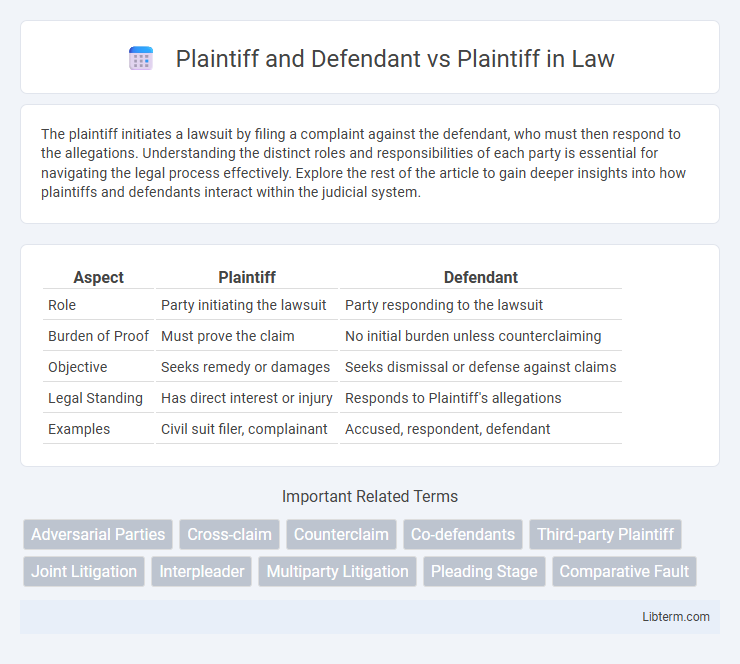The plaintiff initiates a lawsuit by filing a complaint against the defendant, who must then respond to the allegations. Understanding the distinct roles and responsibilities of each party is essential for navigating the legal process effectively. Explore the rest of the article to gain deeper insights into how plaintiffs and defendants interact within the judicial system.
Table of Comparison
| Aspect | Plaintiff | Defendant |
|---|---|---|
| Role | Party initiating the lawsuit | Party responding to the lawsuit |
| Burden of Proof | Must prove the claim | No initial burden unless counterclaiming |
| Objective | Seeks remedy or damages | Seeks dismissal or defense against claims |
| Legal Standing | Has direct interest or injury | Responds to Plaintiff's allegations |
| Examples | Civil suit filer, complainant | Accused, respondent, defendant |
Understanding the Roles: Plaintiff vs. Defendant
The plaintiff is the party who initiates a lawsuit by filing a complaint, seeking legal remedy or compensation for alleged harm caused by the defendant. The defendant is the party against whom the lawsuit is filed and is responsible for responding to the plaintiff's claims, often defending against the allegations in court. Understanding the roles of plaintiff and defendant is essential for grasping the dynamics of civil litigation and the legal process in resolving disputes.
Key Differences Between Plaintiff and Defendant
The plaintiff is the party who initiates a lawsuit by filing a complaint, seeking legal remedy, while the defendant is the party against whom the complaint is filed and who must respond to the allegations. Key differences include the plaintiff bearing the burden of proof to establish the defendant's liability, whereas the defendant's role centers on defending against those claims. In court proceedings, the plaintiff presents evidence first, aiming to demonstrate wrongdoing, while the defendant counters with defenses, evidence, or motions to dismiss.
Legal Rights and Responsibilities of Plaintiffs
Plaintiffs hold the legal right to initiate a lawsuit seeking remedies for alleged wrongs or damages, ensuring their grievances are formally addressed in court. They bear the responsibility to present credible evidence, articulate claims clearly, and comply with procedural rules to establish the defendant's liability. Understanding these rights and duties enables plaintiffs to effectively pursue justice while upholding the integrity of the legal process.
Legal Rights and Responsibilities of Defendants
Defendants in a lawsuit have the legal right to receive notice of the claims against them and to respond through pleadings or motions, ensuring due process. They bear the responsibility to comply with court procedures, including providing evidence and attending hearings, while maintaining the burden of defense against the plaintiff's allegations. Defendants may also assert counterclaims or defenses, leveraging statutes and case law to protect their interests and avoid liability.
Common Legal Strategies for Plaintiffs
Plaintiffs in cases against Defendants often prioritize gathering comprehensive evidence to establish liability and damages. They commonly employ detailed legal pleadings to define clear claims and leverage discovery to obtain crucial information for building a strong case. Strategic negotiation and settlement discussions are also utilized to achieve favorable outcomes without prolonged litigation.
Common Legal Strategies for Defendants
Defendants in cases labeled Plaintiff and Defendant vs Plaintiff often employ common legal strategies such as filing motions to dismiss based on procedural errors or lack of jurisdiction. They may also counterclaim or challenge the plaintiff's evidence through rigorous discovery processes and expert testimonies to weaken the plaintiff's case. Emphasizing legal defenses like statute of limitations, lack of standing, or failure to state a claim can significantly impact the case outcome.
Typical Lawsuit Process: Plaintiff vs. Defendant
The typical lawsuit process begins with the plaintiff filing a complaint against the defendant, outlining the legal claims and damages sought. The defendant responds with an answer, addressing the allegations and potentially filing counterclaims. Discovery follows, involving the exchange of evidence, leading to motions, settlement discussions, and potentially a trial if no resolution is reached.
Burden of Proof: What Plaintiffs Must Prove
The burden of proof requires plaintiffs to establish their claims by a preponderance of the evidence, meaning they must show it is more likely than not that their allegations are true. Plaintiffs must present sufficient factual evidence supporting each element of their cause of action to meet legal standards. Failure to meet the burden of proof typically results in dismissal of the case or judgment in favor of the defendant.
Common Legal Misconceptions: Plaintiff vs. Defendant
Common legal misconceptions often confuse the roles of plaintiff and defendant, with many assuming the plaintiff is always at fault or the defendant always innocent. In reality, the plaintiff initiates the lawsuit by alleging harm, seeking remedy, while the defendant responds to those claims and defends against liability. Understanding these distinct roles is crucial for accurate legal interpretation and avoiding misjudgments in civil litigation.
When the Plaintiff Becomes a Defendant (Counterclaims Explained)
When the plaintiff becomes a defendant, it typically occurs through the filing of counterclaims by the original defendant. Counterclaims allow the defendant to assert their own claims against the plaintiff within the same legal proceeding, effectively reversing roles. This legal mechanism streamlines dispute resolution by addressing related claims simultaneously, reducing the need for separate lawsuits.
Plaintiff and Defendant Infographic

 libterm.com
libterm.com